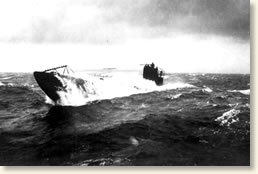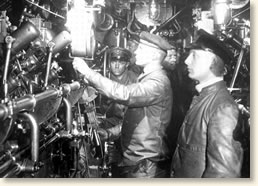|
U-boat Attack, 1916
Prior to World War I, prevailing
naval opinion considered the submarine an ineffective weapon for blockading an
enemy
country. Submarines, filled with exposed piping and crammed with machinery, had
no space to take prisoners aboard. Additionally, the submarine could never carry
enough sailors to provide
crews to man captured ships. Therefore, the submarine was considered a useless
weapon against civilian shipping.
 |
A German U-boat prowls
an angry sea, ca. 1916
|
In February 1915 the German government announced its solution to the problem -- unrestricted submarine warfare. The Germans realized they didn't have to capture a merchant ship, just sink it - crew and all. They declared a war zone around the British Isles within which they would sink any allied merchant vessel on sight. Fifty ships were hit between February and September including the liner Lusitania. One hundred thirty-eight Americans were among the 1,198 lives lost in the Lusitania sinking. American public opinion was outraged, many clamoring for war. President Wilson protested to the Germans. Afraid that America might join the war, and mindful that they didn't have enough subs to do the job right, the Germans suspended their campaign -- but only temporarily.
In February 1917, with U-boats available in quantity, the Germans again declared
their policy of unrestricted submarine warfare. This time not only allied but
neutral ships (such as those of the U.S.) would be sunk on sight. It was a
big gamble. The Germans knew it would bring America into the war. But, they
reasoned they could starve the Brits out first. It was a gamble they almost
won. By April, when America declared war , Britain was almost on its knees.
Over 1,030 merchant ships had been sunk and Britain was only six weeks away
from starvation. The introduction of the escorted convoy helped saved the day.
Ship losses dropped dramatically and the supply route from America to Britain
began to flow.
Adolf K.G.E. von Spiegel commanded a German U-boat during the First World War. He published his memoirs in 1919. Here he describes the attack on a cargo vessel in April 1916.
"The steamer appeared to be close to us and looked colossal. I saw the captain walking on his bridge, a small whistle in his mouth. I saw the crew cleaning the deck forward, and I saw, with surprise and a slight shudder, long rows of wooden partitions right along all decks, from which gleamed the shining black and brown backs of horses."
'Oh heavens, horses! What a pity, those lovely beasts!'
'But it cannot be helped,' I went on thinking. 'War is war, and every horse the fewer on the Western front is a reduction of England's fighting power.' I must acknowledge, however, that the thought of what must come was a most unpleasant one, and I will describe what happened as briefly as possible."
'Stand by for firing a torpedo!' I called down to the control room.'
'FIRE!'
" A slight tremor went through the boat - the torpedo had gone."
 |
Cramped quarters
A U-boat crew in action, ca. 1916
|
"The death-bringing shot was a true one, and the torpedo ran towards the doomed ship at high speed. I could follow its course exactly by the light streak of bubbles which was left in its wake."
"I saw that the bubble-track of the torpedo had been discovered on the bridge of the steamer, as frightened arms pointed towards the water and the captain put his hands in front of his eyes and waited resignedly. Then a frightful explosion followed, and we were all thrown against one another by the concussion, and then, like Vulcan, huge and majestic, a column of water two hundred metres high and fifty metres broad, terrible in its beauty and power, shot up to the heavens."
'Hit abaft the second funnel,' I shouted down to the control room."
"All her decks were visible to me. From all the hatchways a storming, despairing mass of men were fighting their way on deck, grimy stokers, officers, soldiers, groom, cooks. They all rushed, ran, screamed for boats, tore and thrust one another from the ladders leading down to them, fought for the lifebelts and jostled one another on the sloping deck. All amongst them, rearing, slipping horses are wedged. The starboard boats could not be lowered on account of the list; everyone therefore ran across to the port boats, which in the hurry and panic, had been lowered with great stupidity either half full or overcrowded. The men left behind were wringing their hands in despair and running to and fro along the decks; finally they threw themselves into the water so as to swim to the boats."
"Then - a second explosion, followed by the escape of white hissing steam from all hatchways and scuttles. The white steam drove the horses mad. I saw a beautiful long-tailed dapple-grey horse take a mighty leap over the berthing rails and land into a fully laden boat. At that point I could not bear the sight any longer, and I lowered the periscope and dived deep."
References:
Hough, R., The Great War at Sea (1983); Spiegel, Adolf K.G.E. von, U-boat 202 (1919).
How To Cite This Article:
"U-boat Attack, 1916," EyeWitness to History, www.eyewitnesstohistory.com (1997).
|






